
July 2007
  
Artifacts from the Chilady Family
Reveal Silverhill Immigrant History

"We literally stumbled on Alfred Chilady's part in the early Silverhill colony when Neysa Utter found some long-stored Swedish poetry in her mother-in-law's things that had been stashed away years ago," Zion Lutheran Church's Pastor Dave tells it. "We worked with Donald Johansson, a resident of Robertsdale fluent in Swedish, to translate the longer poem." (That poetry was shared with readers of the Robertsdale Independent several weeks ago.) Research showed that Alfred had been the poet laureate of Silverhill back in the early 1900s. He literally generated poems for any occasions.
What is now Robertsdale and Silverhill comprised the community of Silverhill at that time. "When the poem found by Mrs. Utter was finally translated, we figured the Alfred Chilady story was pretty much complete. But now, Alfred's grandson, Lawrence Chilady has provided information that reveals even more insight into the time of the Swedish immigration to 'the Swedish Colony of Silverhill.'"
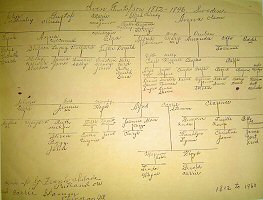 Silverhill's early poet, Alfred Chilady, had changed his name when he emigrated from Sweden. Lawrence Chilady, Alfred's grandson, shared a family tree revealing that the family name in Sweden had been Gustafson, his great grandfather bearing the name Sven Gustafson. So Alfred became known as Chilady and his brother Gustaf Gustafson became known as Gustaf Chilade, an alternative spelling.
- Click photo to enlarge.
Silverhill's early poet, Alfred Chilady, had changed his name when he emigrated from Sweden. Lawrence Chilady, Alfred's grandson, shared a family tree revealing that the family name in Sweden had been Gustafson, his great grandfather bearing the name Sven Gustafson. So Alfred became known as Chilady and his brother Gustaf Gustafson became known as Gustaf Chilade, an alternative spelling.
- Click photo to enlarge.
"The name 'Gustafson' was very common in Sweden. So, my grandfather apparently took the new name 'Chilady' when he came to this country. His brother Gustaf did the same, only spelling the name 'Chilade.' I don't know why they chose that name," Lawrence Chilady says. "I've got a family tree that shows how the Sven Gustafson (1812-1896) family grew." The Gustafson sir name basically disappeared with the emigration from Sweden. It was not uncommon for emigres to take new names when they came to the United States for a new life. A new life "required" a new name.
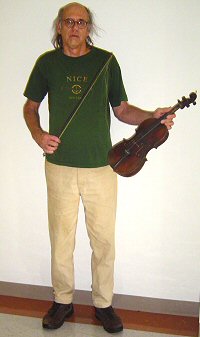 Alfred was apparently gifted on a number of levels. "We were aware of his poetry gifts, but the violin artifact Lawrence shared with us revealed the man was able to craft instruments of wood, and we understand that he was accomplished on the violin. We don't know if he was 'classical,' e.g., a 'violinist,' or a 'fiddler'", Pastor Dave says. The violin workmanship does reveal a man skilled in close handwork.
In the family archives, there is further indication of Alfred Chilady's connection with church activities. Although the picture is quite faded, there Alfred stands with his Sunday School class. The two poems originally discovered by Neysa Utter had a church connection, one a funeral, the other God's beneficence.
Alfred was apparently gifted on a number of levels. "We were aware of his poetry gifts, but the violin artifact Lawrence shared with us revealed the man was able to craft instruments of wood, and we understand that he was accomplished on the violin. We don't know if he was 'classical,' e.g., a 'violinist,' or a 'fiddler'", Pastor Dave says. The violin workmanship does reveal a man skilled in close handwork.
In the family archives, there is further indication of Alfred Chilady's connection with church activities. Although the picture is quite faded, there Alfred stands with his Sunday School class. The two poems originally discovered by Neysa Utter had a church connection, one a funeral, the other God's beneficence.
Family traits are sometimes easy to follow. It is interesting that the Chilady grandson Lawrence is both a poet and artist. (People interested in his artwork can contact him at 947-5610.) Perhaps some of Alfred's skills are still with us in his remaining family.

June 2007
  
Immigrant History Revealed
in Century Old Silverhill Swedish Poem

The story really begins a century and a half ago. Alfred Chilady was born on June 18, 1855, in Norra Höke, Kila, Sweden. He would join 20 percent of the Swedish population who emigrated from the homeland for economic reasons, many settling on the northern plains of the United States.
One small group, settling in Chicago, Illinois, began a purely Swedish Colony in central Baldwin County in an area that was already known as Silverhill. Alfred had been head groundskeeper for Lincoln Park in Chicago before coming to Silverhill. Alfred's mother (or possibly his wife) had been lady-in-waiting to the queen of Sweden before Alfred's journey to America.
He would be part of a large group of Swedes who had a life-changing experience in the Great Awakening of Northern Europe at the time, an experience that would birth Silverhill First Baptist, Silverhill Covenant, and Zion Lutheran Churches a half century after his birth. And it is a church history, which revealed who Alfred Chilady was. He would be nameless and lost to local history except for one fact. We get a clue from
"A CHURCH HISTORY OF FIRST BAPTIST, SILVERHILL: 1899 - 1949", which states that "in 1905 a pump organ was purchased ... [and] a special dedication service was held for the occasion with Mr. Chilady in charge. Mr. Chilady was an inspiration to the community, writing a poem for every special occasion." It later notes that he became Sunday School Superintendent in 1906. That information places Alfred Chilady in Silverhill, Alabama, by 1906 and he was writing poetry.
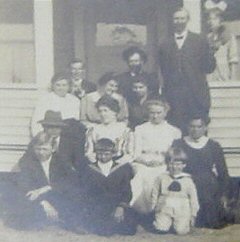 A faded photo from the early 1900s survived in the Chilady
family. We don't know who the people are, but the fellow standing
toward the rear on the right is Alfred Chilady. Lawrence Chilady
believes this group was a Sunday School Class. Given Alfred's
commitment to what is now Silverhill First Baptist, the background may
be the original church edifice or the parsonage for the old Swedish
Baptist Church.
A faded photo from the early 1900s survived in the Chilady
family. We don't know who the people are, but the fellow standing
toward the rear on the right is Alfred Chilady. Lawrence Chilady
believes this group was a Sunday School Class. Given Alfred's
commitment to what is now Silverhill First Baptist, the background may
be the original church edifice or the parsonage for the old Swedish
Baptist Church.
Now, skip ahead a whole century. Zion Lutheran Church's Neysa Utter of Silverhill was going through some old boxes of artifacts from husband Ralph Utter's mother, Agnes Johnson Utter. “Those boxes have been in storage forever,” she noted. These boxes have history in them, because Agnes was a daughter of civic booster Oscar Johnson, a Silverhill founder in 1896 and later, Mayor of Silverhill.
The boxes contained two poems along with other artifacts that had been saved for almost a century. One poem is directly linked to October 18, 1918. Nancy Ewing who keeps the records of Silverhill Cemetery, did some digging and discovered the poem was a Swedish eulogy prepared for the funeral of Ralph Wicklund whose wife was a member of Zion Lutheran Church. Apparently, Chilady was well known and was called upon by the Silverhill Swedish community to compose verse for many occasions.
But Neysa had discovered another poem besides the eulogy, undated, and “long” in Chilady’s handwriting, a script that was probably dated in its time, and now long out of date and hard to decipher. We suspected that Alfred Chilady was the author based on the name and handwriting on the associated eulogy. The title of the second piece was "For och Nu," probably translating something like "Then and Now" in English. But when was then and now, because there was no date! And what did it say? We did contact Lawrence Chilady, Alfred's great grandson who still lives near the homestead that he noted had been purchased by Alfred in 1904. He reported that Alfred passed away in the 1930s. So, this second poem apparently dated to between 1904 and 1930 or so.
These artifacts were introduced to the Silverhill community by Zion Lutheran Church’s Museum for Silverhill’s Heritage Day in 2006. Donald Johansson was reading the INDEPENDENT and came across the mystery of this poem and what it had to say about the times in Silverhill (and Robertsdale, which was considered part of Silverhill a century ago).
Fluent in Swedish, Johansson stated, “I have tried to interpret all the writing in the poem before translating it. Most of it I was able to understand, but there are a few passages that I couldn't figure out. So I sent the files to some people I know in Sweden that are into genealogy, and much better at interpreting old handwritings. In fact, this is the person who is actually related to the author of the poem.”
Johansson waited for a reply. He noted earlier this year that, “I am still waiting on hearing back from them. Basically, from what I understand, it sounds like a poem that might have been written to be published in some sort of Swedish magazine that they received in the colony from back home in Sweden. He tells some about the life in the colony, and also goes on to 'brag' some on how they had taught the 'Southerners' one or two things about life and farming.”
Johansson, not completely sure of some of the script, was hoping for help from the Old Country to verify what it was saying. He noted that “there are really only a few lines I am unsure of, and I hope to have a complete English translation of the poem to you soon.”
Months pass. And then comes an e-mail, which tells the final chapter in the story of this second poem. “Sorry for being so very slow in getting back to you on this,” he said. “The people I sent this to in Sweden were not able to interpret any more of the handwriting than I had already been able to. So while there are a few words missing, I have gone ahead and translated everything I was able to read.” The handwriting was indeed hard to decipher.
More than a half-year’s work on recovering history of Silverhill in this poem results in an English translation. Donald Johansson notes that “I translated the meaning literally, so of course it loses most of the rhymes and the meter in the English version. It sounds like this was written for some sort of publication, telling people about Silverhill. At places it is a bit boastful in tone and a little condescending towards the locals who lived here before the Swedes arrived.”
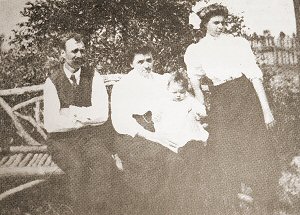 Alfred Chilady, pictured here with his family, was a well-known local poet and composed occasional verse in the early Silverhill Swedish community. He is the probable author of this long poem, which follows, "For och Nu," of a century ago.
- Click photo to enlarge.
Alfred Chilady, pictured here with his family, was a well-known local poet and composed occasional verse in the early Silverhill Swedish community. He is the probable author of this long poem, which follows, "For och Nu," of a century ago.
- Click photo to enlarge.

"For och Nu" by Alfred Chilady (Circa 1918?)
The century old manuscript in Swedish concludes with, "we
live well here in Silverhill." Local poet Alfred Chilady may have
crafted this poem for an unidentified publication. The manuscript and
its translation by Donald Johansson of Robertsdale are displayed in the
Zion Lutheran Church museum.

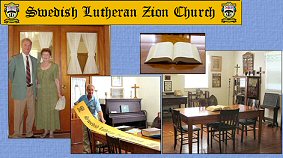
Zion Lutheran Museum

|
Scanned Page
|
"For och Nu"
by Alfred Chilady (Circa 1918?)
|
"Then and Now"
Translated by Donald Johansson
|
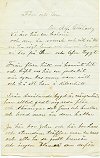
Page 1
|
Vi äro har en koloni
Och den ar svensk och vill sa bli
Vi ha rojt land och hus vi byggt
Vi tro pa Gud och lefva tryggt
|
We are here in a colony,
And it is Swedish and shall so be.
We have cleared land and built houses.
We believe in God and live securely.
|
Fran flera hall vi kommit hit
Och kopt oss har en jordavit
Var egen bas man vara vill
Och ha ett hem I Silverhill.
|
From many places we have come here
And bought ourselves a piece of land.
One wants to be one’s own boss
And have a home in Silverhill.
|
Fram smalands bygd ar mangen har
Han alltid godt sig reda plar (?)
Och skaningar det finns och knallar
Och hvad man an dem kallar
|
From the Smaland area are many here.
He is always coping very well.
And Skanes there are and “Knallar”
Or whatever else you call them*
|
Ja har bor John och har bor Lars
Och stundom traffar man en mas
Och alla ha de godt humor
Och ingen “blame” (?) dom derfor
|
Yes, here lives John and here lives Lars,
And now and then you meet a “mas”,
And everyone is in good spirits,
And no-one blames them for that.**
|
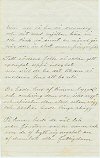
Page 2
|
Men nu sa har vi creamery
Och dit med mjolken kora vi
Och tank so snart en manad gar
Nar den ar slut man pangar far
|
But now we have a creamery,
And to that we drive with our milk--
And imagine, as soon as a month has passed,
When it is over you get paid!
|
Till soderns folk vi redan gett
exempel uppa idoghet
Nu vill de har det liksom vi
Moderna hus att bo uti
|
To the Southern people we have already given
Examples of industriousness.
Now they want, just like us,
Modern houses to live in
|
De hade hus af timmer byggt
Och omkring dem var icke snygt
Och spiseln den stod utom vagg
Och bockar hade langa skagg
|
They had built houses out of timber,
And around them wasn’t pretty.
And the stove was out-of-doors,
And the goats had long beards.
|
Pa husen hade de val tak
Men fonster – var en annan sak
Som de ej brytt sig mycket om
Af dumhet eller fattigdom
|
On the houses they had roofs,
But windows – that was another matter.
That they hadn’t cared about,
Out of ignorance or poverty.
|
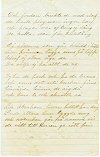
Page 3
|
Och jorden brukte de med slarf
De hade plog men ingen harf
Och plogen var ej tung ej lang
De kallar den for buletang (?)
|
And the land they used recklessly.
They had plows but no harrows,
And the plow wasn’t heavy or long;
They called it “buletång”.
|
Ej soderns son gar kladd I ---
Men kvinnor lagga snus pa lapp
Behof en stora aga de
De vilja ej ha allt de se
|
The son of the south does not dress in ***,
But the women put snuff on their lips.
They don’t have very big needs;
They don’t want everything they see.
|
Ty har de frock och har de beans (?)
Och snus det uti burken finns
Fornojda kanna de sig da
Och bara le och skratta sa
|
Because if they have clothes and beans,
And there is snuff in their jar,
Then they feel satisfied,
And only smile and laugh.
|
Lik Abraham hvar ---
Guds altare han byggde nog
Och ---
De vill till herran ge sitt pris
|
Like Abraham whose [ ? ]
God’s altar he built,
And [ ? ] goes in such a way.
They want to give their praise to the Lord.
|
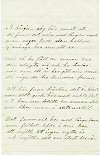
Page 4
|
I borjan sag har annat ut
Da fanns det svin med lang en snut
Man razor back dem kallade
Ej manga aro nu att se
|
In the beginning it looked different here.
Then there were pigs with a long snout.
Those were called Razorbacks.
Not many of those are now to see
|
Men vi ha fatt en annan ras
Den slagta vi och ha kalas
Nar som ett ar har gatt sin rund
Da vaga de tre hundra pund
|
But now we have a different breed
That we slaughter and have a feast.
When a year has come to pass
Then they weigh three hundred pounds.
|
Att har fans hastar det ar klar
Men allt gick har med sakta fart
Det har nu blitt en annan stil
Nu aker man I automobile
|
Of course there were horses here,
But everything moved in a slow pace.
Now there is a different style;
Now you travel in automobiles.
|
Det fanns val kor med langa horn
Men folket lefde in den tron
Att mjolk till ingen nytta ar
Och mjolka det var stort besvar
|
There were some cows with long horns,
But people held the belief
That milk was of no good use,
And milking was a great difficulty.
|
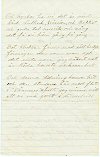
Page 5
|
Och kyrkor ha vi det ar visst
Bad Luthersk, Mission och Baptist
Och goda tal musik och sang
Det fa vi hora gang pa gang
|
And Churches we have, that’s for sure!
Both Lutheran, Missionary and Baptist,
And good sermons, music and song
We get to hear time after time.
|
Det klubbar finns med sitt bestyr
Foreningar der som man syr
Det sista som jag sakert vet
Ar roda korsets verksamhet
|
Clubs there are with their hustle--
Organizations where you do sewing.
The last one I know for sure
Is the activity of the Red Cross.
|
Och denna tidning kommer hit
Och den studeras har med flit
I “vanners” spalt jag namna vill
At vi ma godt I Silverhill
|
And this newspaper comes here,
And it is studied very carefully.
In the “friends” column I want to mention
That we live well here in Silverhill.
|
*Smaland is a region in southern Sweden. “Skanes” comes from the region of Skåne in the very south of Sweden, and “Knallar” is a traditional name for trades people from the region of Västergotland.
**Mas is the traditional name for someone from the Swedish region of Dalarna.
*** Probably something that a woman wears.

December 2006
  
Swedish Artifacts

Swedish artifacts continue to come "out of the woodwork" as they relate to early Silverhill. Mrs. Ewing dropped off a full set of "Allers illustrerade Konversationslexican: Praktisk Uppslagsbok i det allmanna Velandsts Olika Grenar" produced in Helsingborg, Sweden, in 1903. Pastor Jesse Adams of Silverhill Covenant Church passed them on to Pastor Dave Johnson for the Zion church museum which features a variety of Swedish artifacts from a century ago.
There is an obvious Swedish connection to this story. Silverhill First Baptist, Silverhill Covenant, and Swedish Lutheran Zion (aka Zion Lutheran Church) grew out of a common Swedish heritage. The interweaving of church members and memberships is only a suspicion at this point, but there is here a Baptist Chilady with a Lutheran Mrs. Wicklund.
The Covenant History for the year 1918 states, "The Lutherans had now built a church and parsonage so the Lutheran friends withdrew from the Mission Sunday School to organize one of their own." This would seem to indicate there had also been close ties between the Covenant and Lutheran congregations.

November 2006
  
Zion Lutheran Church History
Swedish Poetry

Two pieces of Swedish poetry (c. 1918) commemorating events in early Silverhill were discovered by Neysa Utter as she examined the contents of boxes of memorabilia from her motherinlaw, Agnes Johnson Utter, daughter of Silverhill founder in 1896 Oscar Johnson and later, Mayor of Silverhill. Scanned copies can be viewed below. Click each page for a larger view. The actual items are on display in the Museum of Zion Lutheran Church in beautiful Silverhill.
 Alfred Chilady and his family pictured in Silverhill in 1908. Alfred Chilady was born June 18, 1855, in Norra Höke, Kila, Sweden. He came to America in 1886. His wife Christina was born in Sweden in January 1865. She came to America in 1891 and married Alfred the same year. Their daughter Ruth was born in Chicago in February 1895. The family moved to Silverhill some time between 1900 and 1906. Their son Lawrence was born in the Silverhill area May 26, 1908. - Click photo to enlarge.
Alfred Chilady and his family pictured in Silverhill in 1908. Alfred Chilady was born June 18, 1855, in Norra Höke, Kila, Sweden. He came to America in 1886. His wife Christina was born in Sweden in January 1865. She came to America in 1891 and married Alfred the same year. Their daughter Ruth was born in Chicago in February 1895. The family moved to Silverhill some time between 1900 and 1906. Their son Lawrence was born in the Silverhill area May 26, 1908. - Click photo to enlarge.
The first piece, a document of 48 lines, is apparently by Alfred Chilady.
"A CHURCH HISTORY OF FIRST BAPTIST, SILVERHILL: 1899 - 1949", reports that, "in 1905 a pump organ was purchased ... [and] a special dedication service was held for the occasion with Mr. Chilady in charge. Mr. Chilady was an inspiration to the community, writing a poem for every special occasion." It later notes that he became Sunday School Superintendent in 1906. So, Alfred was in the Silverhill by 1906 and the poem, "For och Nu," may date from that time. Title? We think it probably is something like "Then and Now" in English. Lawrence Chilady, Alfred's great grandson who still lives near the homestead that was purchased in 1904, reports that Alfred passed away in the 1930s, so this poem may date between 1904 and 1930 or so.
  
The second piece, of 30 lines, has no title, but it is dated either March 10, 1918, or October 3, 1918. We took this information to Nancy Ewing who keeps the records of Silverhill Cemetery. Mrs. Ewing did some digging and came up with some interesting information. This Swedish eulogy had apparently been prepared for the funeral of Ralph Wicklund on October 18, 1918, the date on the paper apparently being a date of death or perhaps a preparation date of the eulogy, since Chilady was well known and called on to compose verse for various events.
There are more details. Zion Lutheran Church has no records of Ralph Wicklund being a member of Zion, but his wife was, apparently from 1914 to 1918. Records prior to 1915 are very "spotty" for a number of historical reasons, but it appears that Ralph was the husband of Zion Member Mrs. Wicklund. Cemetery records reveal that Rev. A. Nelson presided at the funeral. Zion had no pastor at that time, but Swedish Augustana Synod Seminarian Arnold Nelson had spent a second summer in Silverhill in 1918 and is the apparent "Rev". Mr. Nelson would ultimately marry one of Silverhill's own, Miss Hildur Swenson. The language at the funeral service would have been Swedish, since that language was used for church-related activities until 1919, hence the Swedish-verse eulogy.
What we call "Silverhill" and "Robertsdale" today were part of what was just considered "Silverhill" in those early days of the 1900s. The handwriting from the two pieces suggest that Chilady is the author of the second poem as well as the first.
Swedish translation is somewhat difficult since the vocabulary and verse syntax of this period poetry make for a tedious and circitous interpretation. The first piece apparently begins with, "We are here in the colony/ and they are Swedish ...." The second piece has not been as easy to interpret. A copy of the poems have been sent to the American Swedish Institute in Minneapolis, Minnesota, which may be able to assist in translation of this Swedish which now is "archaic." Assistance from our broader Silverhill community would also be appreciated.

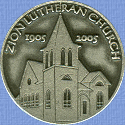

|